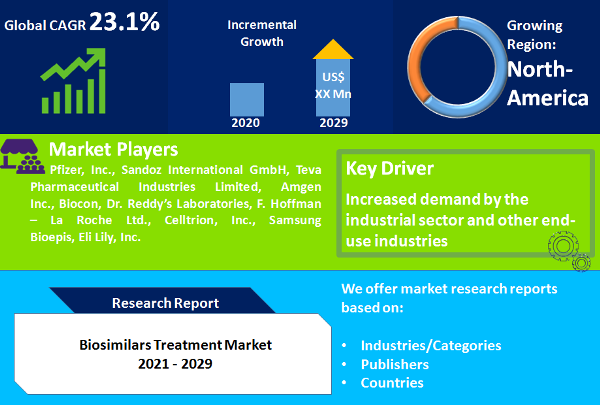This report on global biosimilars market studies the increasing demand for biosimilars as the number of biologics drugs used for chronic diseases are set to expire in the next 3-5 years, growing pressure to curtail healthcare expenditure, cost effectiveness of biosimilars and strategic collaborations resulting into enhanced productivity and clinical trials activities for biosimilars.
For the purpose of this study, the biosimilars market is segmented into product (recombinant non-glycosylated proteins, recombinant glycosylated proteins and recombinant peptides) and application type (oncology, chronic and autoimmune disorders, blood disorders, growth hormone disease and infectious disease); Market size estimates and forecast for these segments for the period 2019 to 2029 are provided in terms of US$ Mn along with the respective CAGRs for the period 2021 to 2029, considering 2020 as the base year.
The pipeline analysis for biosimilars market comprises projected market sales of Phase III drugs estimated till 2029. We have estimated sales of very specific molecules based on the type (SB4, HX575, ABP 980, and M834), sponsor, depicted peak sales by leading market experts and other factors.

The geographic segmentation of the global biosimilars market is performed for the regions North America, Europe, Asia Pacific, Latin America and Middle East and Africa markets. The regions are also further sub-segmented on the basis of major countries. Market size estimates and forecast for these segments for the period 2019 to 2029 are provided in terms of US$ Mn along with the respective CAGRs for the period 2021 to 2029, considering 2020 as the base year.
Based on products types, the global biosimilars market is categorized into:
According to market experts, the recombinant non-glycosylated proteins is expected to dominate the product segment due to growing incidence of diabetes, presence of several versions of insulin in the market and launch of cost effective products. The recombinant glycosylated proteins will record the fastest growth in the biosimilars product segment as need of erythropoietin to counter blood related disorders is increasing due to high priced biologics and frequent application. Overall, the global biosimilars market is highly competitive with presence of multiple players like Pfizer, Inc., Biocon, F.Hoffman-La Roche AG, Amgen, Inc. etc. specializing in respective fields. Consolidation activities are being increasingly witnessed on the competitive front with a view to increase the technological advancement in the biosimilars market.
Based on Application, the global biosimilars market is categorized into:
Oncology is expected to dominate the application segment due to rising incidences of cancer, high cost of biologics, and the pressure to reduce the healthcare expenditure. In base year 2020, biosimilars application for autoimmune disease and chronic disease showed great potential due to the changing off patent scenario. During the forecast period 2021 – 2029 blood disease biosimilars are expected to project a significant growth due to high priced reference biologics and their frequent application. The key factors assisting the biosimilar market growth are the increasing prevalence of chronic disease, aging population, and cost effectiveness of biosimilars and government initiatives to promote biosimilars for e.g. Europe Medicines Agency (EMA) has finalized the guidelines on biosimilars with its elements described in ICH (Q5E).
North America was observed as the largest market for biosimilars in the base year 2020. According to Centre for Disease Control and Prevention, in 2012 about half the adult’s i.e. 117 million people suffered from chronic disease, which can be considered as a potential market for biosimilars. According to World Health Organization, over one third of the European population above the age of 15 suffer from chronic disease. Europe is expected to be the second largest market due to rising public awareness of chronic disease, improved healthcare infrastructure. Newly approved biosimilars molecules have a good acceptance and penetration rate in the European market. Growth of Asia Pacific for biosimilars market is attributed by factors like rising prevalence of chronic disease, increasing investments in R&D and higher disposable income in these regions. However, factors such as high prevalence of chronic disease, developing healthcare infrastructure, increasing awareness among people about health care and aging population are going to fuel the rapid growth of biosimilars market in Latin America and Middle East and Africa region in the near future.
Historical & Forecast Period
This study report represents analysis of each segment from 2023 to 2033 considering 2024 as the base year. Compounded Annual Growth Rate (CAGR) for each of the respective segments estimated for the forecast period of 2025 to 2033.
The current report comprises of quantitative market estimations for each micro market for every geographical region and qualitative market analysis such as micro and macro environment analysis, market trends, competitive intelligence, segment analysis, porters five force model, top winning strategies, top investment markets, emerging trends and technological analysis, case studies, strategic conclusions and recommendations and other key market insights.
Research Methodology
The complete research study was conducted in three phases, namely: secondary research, primary research, and expert panel review. key data point that enables the estimation of Biosimilars Treatment market are as follows:
Market forecast was performed through proprietary software that analyzes various qualitative and quantitative factors. Growth rate and CAGR were estimated through intensive secondary and primary research. Data triangulation across various data points provides accuracy across various analyzed market segments in the report. Application of both top down and bottom-up approach for validation of market estimation assures logical, methodical and mathematical consistency of the quantitative data.
| ATTRIBUTE | DETAILS |
|---|---|
| Research Period | 2023-2033 |
| Base Year | 2024 |
| Forecast Period | 2025-2033 |
| Historical Year | 2023 |
| Unit | USD Million |
| Segmentation | |
Product
| |
Application
| |
|
Region Segment (2023-2033; US$ Million)
|
Key questions answered in this report